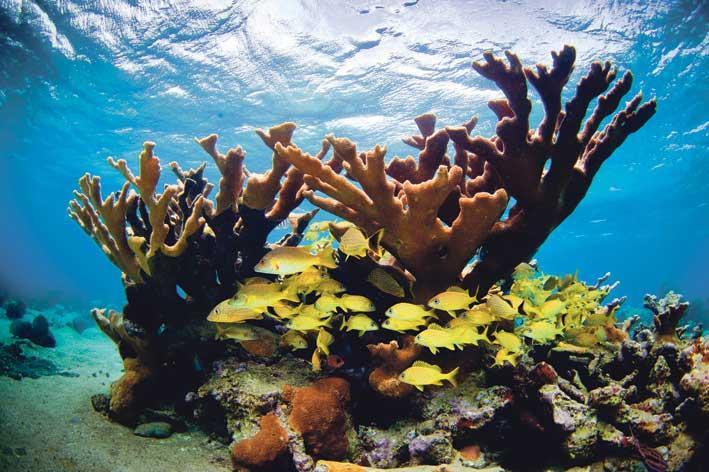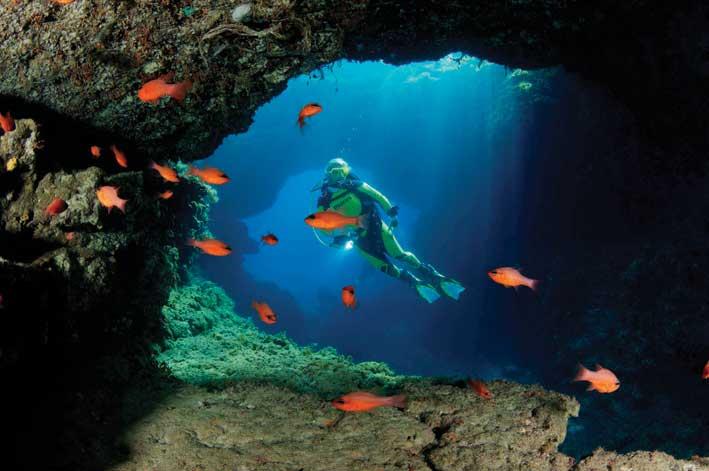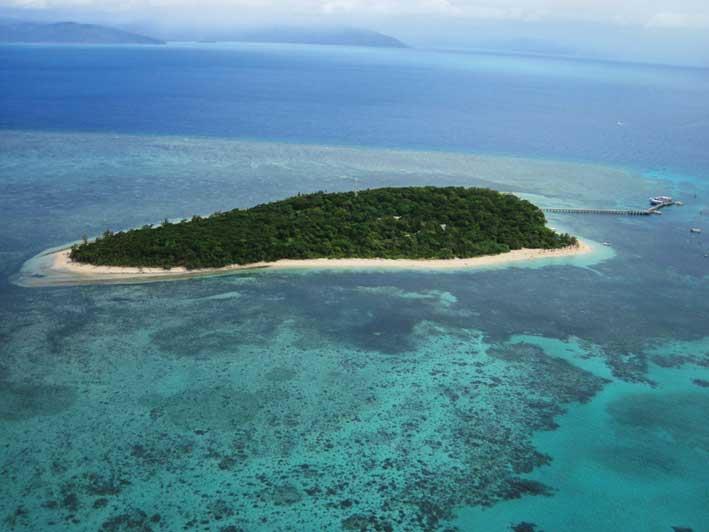Great Blue Hole, Belize
No diving bucket list would be complete without the famous great blue hole in Central America's Belize. The circular 300 metres wide and 125 metres deep submarine sinkhole is part of the larger Belize Barrier Reef Reserve System, a UNESCO World Heritage Site. It is outlined by coral reef and inhabited by Caribbean Reef Sharks and the occasional Hammerhead. There is probably no other experience like it.
With up to 30 metres visibility, imagine coming over a bathwater-warm reef of vibrant colours, descending into a cool, deep blue hole where the water begins to waver and shimmer as you enter the transition from salt to fresh water at about 15 metres. Watch the enormous tuna and other pelagic fish dive into the hole to clean themselves as you briefly remove your octopus to taste the fresh water. Then it's necessaryl to have logged a good amount of diving hours beforehand to be able to descend in confidence a further 25 metres to explore the enormous stalactites hanging from the ceiling like stone-age chandeliers and stalagmites of ancient caverns carved out through erosions during the last ice age. With this depth, it is a technical decompression dive not suitable for beginners.
When to Go
Since Jacques Cousteau's famous dive in 1960's, large amounts of scuba divers come here every
year. Like Cuba, the best time to visit is
between December and April. The
average water temperature is 25 C.

Cuba
When you hear Cuba and diving, the Queen's Gardens (Jardines de la Reina) will most certainly come up. I am sure this remote archipelago lives up to all its expectations, but because of its liveaboard requirements, we had to content with Playa Giron, three hours south of La Havana. However, at no dive did this feel like a second choice. On the contrary. There is a huge variety between deep and shallow dives, walls and caves and tunnels - one almost up to 80 metres long! My favourite dive to day combined some plentiful seascape, with a wall into a cave, and all from a beach entry.
There are many diving areas along Cuba's 5646 km of coast and nearly 100 of the world's 500 shark species are found around here. Many of Cuba's coral reefs and sea grass beds are amongst the most intact marine ecosystems in the region, thanks to environmental protection playing a high priority at official levels.
When to Go
The best time to dive in Cuba is between December and April, outside the hurricane and during dry season, although prices will be higher then. The average water temperature is 25 C.

Malta
No need to venture afar when one has one of the world's best diving spots right at your door step. Another benefit is that you can squeeze in several dives in a relatively short time, if needed, due to Malta's conveniently short distances.
Personally, wrecks have always fascinated me. Lucky for divers, Malta has probably one of the highest density of them in the world, each with its very unique features. The tugboat Rozi MV off Cirkewwa, for instance, has been listed amongst the top three dive sites in Europe. Generally, visibility is great and there is a mass of sea life featuring barracudas, morays, octopus, cuttlefish and even dolphins.
HMS Maori at St. Elmo Bay is also a beautiful wreck with plenty of swim-throughs, lots of marine life and a great place to spot the illusive sea horses. It offers a whole additional set of beauty during night dives as well. There are plenty more wrecks, from minesweepers, over tankers and ocean-liners, and even a plane, all at different depths catering to all levels of diving.
And there is more. Malta's underwater exquisiteness doesn't stop at wrecks. The Blue Hole in Gozo is also often listed amongst the top Mediterranean dive sites. The Santa Maria Caves in Comino are suitable to all levels and very popular due to their fascinating cave systems with great swim-throughs, large underwater tunnels, fascinating views and abundant sea life. You can spot Nudibranch, octopus, crabs, spiny lobster, eels, mullets, shrimp, damselfish and morays. Often Banded Sea Bream will swarm divers who feed them with bread. Some of the caves are half above water. For the underwater photographer possibilities are endless.
When to Go
The warmest months for diving are from June to November with temperatures at times exceeding 20 C.

Australia's Barrier Reef/ Yongala wreck QLD
The Great Barrier Reef. The name resonates, attracting divers from around the world. Listing all great diving sites in this UNESCO World Heritage Site would take at least an article in itself. Thus let me instead focus on one of my absolute favourites.
The SS Yongala is a 109 metre long shipwreck 90 km southeast of Townsville off the coast of Queensland. Full of marine life you may see manta rays, sea snakes, potato cods, octopuses, turtles, bull sharks, tiger sharks, clouds of fish and spectacular coral.
The passenger ship, whose name in the local Aboriginal language means 'broad watering place' was launched in Southampton in 1903 and sank during a cyclone in 1911, killing 122 people, a racehorse and a bull. She had no telegraph facilities and so could not be warned of the weather ahead. In 1981 the Yongala was given official protection under the Historic Shipwrecks Act.
Unfortunately, the recent environmental record is not so good, with coral bleaching occurring across the reef at unprecedented rates. Besides visiting rather sooner than later, this is also an urgent reminder to look after our oceans and environment globally and reduce carbon emissions and pollution as much as we can.
When to Go
The best time to dive the Great Barrier Reef is between August and December when visibility is highest due to less rain and wind. Water temperatures year round hover around 25C.